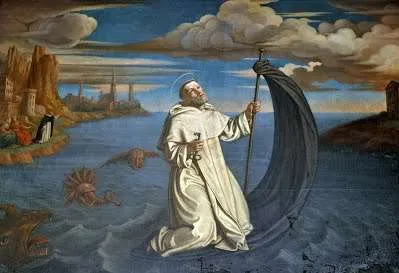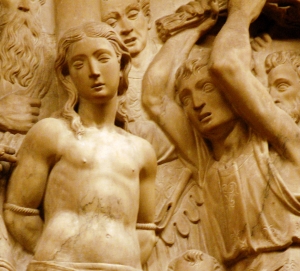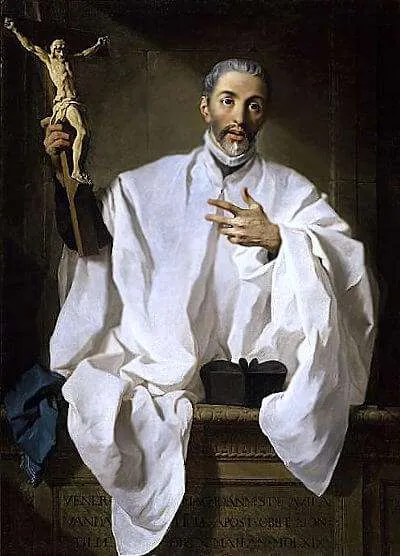1175–1275; Patron Saint of attorneys, canonists, and medical record librarians; Canonized by Pope Clement VIII on April 29, 1601
He was a century old when he died, and his legacy and influence have lived on for many more centuries. Saint Raymond was an evangelist at heart, but he was an educator, lawyer, canonist, organizer, preacher, and penitent by trade. He served the Church in numerous ways throughout his 100 years.
Raymond was born into a noble family in a small town near Barcelona, Spain. He was well educated and began teaching philosophy at the age of twenty. In his thirties, he obtained a doctorate degree in both civil and canon law, becoming an admired teacher for several years. Raymond’s gifts were soon noticed by many people, saints and sinners alike. Among the sinners was the King of Aragon; among the saints were the Bishop of Barcelona and even the pope himself.
While Raymond was still a layman, the Bishop of Barcelona became aware of Raymond’s brilliance and excellent reputation as a professor in Bologna, Italy. The bishop called Raymond back home to Spain to be an archdeacon, grand vicar, and official in his home diocese. Soon after, in his forties, Raymond joined the Dominican Order and began his life as a friar. As a Dominican friar, he gained a reputation for being humble, obedient, and fervent in his devotion and service to others, especially the poor. When he asked his superiors to impose upon him some penance so that he could more fully imitate his Lord, Who was humbly obedient even unto death, the superiors gave him the penance of writing a manual for priests to help them be better confessors. Father Raymond thus composed a magnificent manual of moral theology for confessors, one of the first of its kind. In addition to writing about Confession, Fr. Raymond also became known as a great confessor himself.
Among his penitents was the King of Aragon. Legend has it that on one occasion, the King of Aragon took Fr. Raymond with him on a journey to the Island of Majorca. Though the king was a good man, he suffered from a weakness of sinning with women. Father Raymond confronted the king after he refused to abandon this sin. Father Raymond then asked permission to return to Barcelona. The king refused. At that, the saint was said to have placed his cloak on the sea, stepped onto his “ship,” and speedily sailed across the water to mainland Spain with lightning speed.
In his fifties, Fr. Raymond was summoned to Rome by Pope Gregory IX and was given the monumental task of organizing the many legal decrees of the Church into a single collection, something which had not been done for eighty years. Three years and five volumes later, the Decretals were completed and published by the pope. They became the basis of the Church’s canon law for centuries to come.
The pope was so pleased with Fr. Raymond that he appointed him the Archbishop of Tarragon in Spain. Father Raymond, whose only desire was to be a humble friar, pleaded with the pope to excuse him from the appointment. By divine providence, Fr. Raymond became quite sick before he was ordained a bishop, which helped convince the pope to permit him to remain a humble friar and to return home.
Three years later, while in his early sixties, Fr. Raymond was chosen to be the third Superior General of the Dominican Order. He held the position for only two years before retiring and returning to the life of a humble friar.
Father Raymond could finally do what he loved. He preached, evangelized, catechized, and heard confessions. He felt especially called to preach to Jews and Muslims and helped establish schools where his fellow friars could learn Hebrew and Arabic to help them better evangelize these non-Christians. To help this endeavor, he encouraged another soon-to-be saint, Saint Thomas Aquinas, to write one of his greatest works, Against the Gentiles, to provide a theological basis for this evangelization. When Fr. Raymond was in his early eighties, he wrote a letter to his Superior General stating that 10,000 Muslims had been converted and baptized through his evangelical efforts.
On his deathbed he was visited by princes, princesses, two kings, and one queen. He prayed and fasted continuously, and miracles were even attributed to his intercession. He now rests in Heaven while his earthly body lies in the Cathedral of Barcelona, Spain.
Source: https://mycatholic.life/saints/saints-of-the-liturgical-year/january-7-saint-raymond-of-penyafort/








